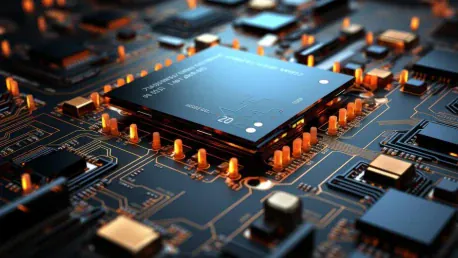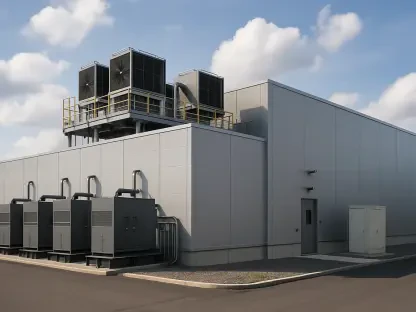The Biden Administration is making a significant move to bolster the United States’ semiconductor industry by establishing a flagship national research and development (R&D) facility in Albany, New York. This initiative, known as the EUV Accelerator project, represents an $825 million investment aimed at advancing Extreme Ultraviolet (EUV) lithography technology, which is crucial for producing next-generation microchips.
Strategic Investment in Semiconductor Technology
Leveraging Existing Infrastructure
The new R&D center will be housed within the existing NanoTech Complex in Albany, NY. This facility is already a hub for semiconductor research, featuring partnerships with major corporations like IBM, Micron, Applied Materials, and Tokyo Electron. By building on this established infrastructure, the EUV Accelerator project aims to expedite the development and adoption of EUV lithography in the United States. Utilizing pre-existing resources not only saves time but also leverages the expertise and successes of longstanding industry partners. This strategic move aims to strengthen America’s position in the global semiconductor arena.
Moreover, the NanoTech Complex’s existing collaborations provide a strong foundation to support the necessary advancements in EUV lithography. EUV technology is critical as the industry continues to shrink the size of transistors to create faster and more efficient microchips. The new facility intends to harness this potential, ensuring that American semiconductor manufacturing remains at the forefront of technological innovation. This concerted effort seeks to counter global competitive pressures and drive the United States to the pinnacle of semiconductor research and development.
Importance of EUV Lithography
EUV lithography is a sophisticated technique essential for transferring intricate patterns onto semiconductor silicon wafers. This technology is critical for manufacturing high-performance integrated circuits and microchips, which are vital for applications in artificial intelligence (AI) and advanced computing. The ability to produce transistors smaller than 7 nanometers (nm) is key to continuing Moore’s Law, which predicts the doubling of transistors on a microchip approximately every two years. As industries increasingly demand smaller, more powerful chips, EUV lithography’s role becomes indispensable in meeting these technological needs.
EUV lithography enables the fabrication of chips that power everything from smartphones to supercomputers, integrating them into numerous facets of modern life. By significantly reducing the size of transistors, EUV lithography enhances processing power and efficiency while consuming less energy. This technological leap forward is not just pivotal for consumer electronics but also for critical sectors like health, defense, and the broader tech industry. Emphasizing this innovation at the new Albany R&D center aligns with national goals to remain a leader in semiconductor technology.
Goals and Objectives of the Initiative
Extending US Leadership in Technology
The National Science and Technology Council (NSTC) has outlined three primary goals for the EUV Accelerator project: extending US leadership in technology, reducing the time and costs associated with prototyping, and establishing a sustainable semiconductor workforce ecosystem. Secretary of Commerce Gina Raimondo emphasized that this initiative is a significant step towards maintaining the United States’ position as a global leader in semiconductor innovation and R&D. By fostering an environment ripe for discovery and application, the NSTC aims to solidify the United States’ dominance in this critical field.
This commitment to technological leadership involves substantial investment not only in cutting-edge equipment but also in intellectual capital and workforce development. Focusing on reducing the time and costs linked to prototyping accelerates the innovation cycle, making it possible to bring groundbreaking advancements to market more swiftly. Additionally, by building a sustainable semiconductor workforce ecosystem, the initiative ensures a steady pipeline of highly skilled professionals, which is essential for maintaining long-term leadership and resilience in the semiconductor sector.
Addressing Global Competitive Pressures
The establishment of the new center is a direct response to global competitive pressures, particularly from China, which is heavily investing in semiconductor design and manufacturing. Despite export controls limiting access to EUV technology, China is expected to develop competitive systems in the next few years. Therefore, it is critical for the US to develop a competitive R&D program to stimulate local production and maintain its technological edge. This move aims to preempt potential threats by ensuring that American semiconductor capabilities remain unparalleled and independent of foreign influences.
Addressing these competitive pressures involves not just technological advancements but also strategic policy decisions. By creating a robust domestic infrastructure, the United States aims to thwart any dependency on foreign technology and supply chains. As geopolitical tensions rise, securing a self-sufficient and resilient semiconductor industry becomes a national priority. The new R&D center in Albany embodies this strategy, positioning the United States to lead the global semiconductor landscape decisively and sustainably.
Impact on the Semiconductor Ecosystem
Broad Industry Implications
The implications of this R&D center extend beyond the semiconductor giants like TSMC, Intel, Samsung, SK Hynix, and Micron. It will also impact a broader ecosystem that includes fabless chip makers (e.g., NVIDIA and AMD), networking providers (e.g., Broadcom), wireless providers (e.g., Qualcomm), and cloud providers (e.g., AWS, Azure, and Google Cloud Platform). Major tech firms such as Meta, Oracle, Cisco, and Juniper are also expected to benefit from the advanced innovations stemming from the new facility. This comprehensive influence underscores the center’s potential to drive widespread industry growth and innovation.
The ripple effects of technological advancements in EUV lithography will resonate across various sectors, fostering innovation and efficiency. These breakthroughs will enable smaller, more powerful, and energy-efficient chips, essential for next-generation applications in AI, Internet of Things (IoT), and 5G technologies. Consequently, this initiative promises to catalyze growth and competitiveness across a range of industries, underlining the strategic importance of the new R&D center.
Job Creation and National Security
The advent of EUV technology on American soil is poised to create a significant number of new jobs, both directly within the semiconductor industry and indirectly across various sectors. Furthermore, the national security implications are substantial, as increasing the domestic semiconductor workforce resilience can benefit the Department of Defense. Job creation spans technical, engineering, and manufacturing roles, providing employment opportunities for a diverse workforce and supporting broader economic growth.
Moreover, the strategic importance of a strong domestic semiconductor industry cannot be overstated. The COVID-19 pandemic highlighted vulnerabilities in supply chains, and bolstering domestic production addresses these weaknesses. A resilient semiconductor workforce is also vital for national security, ensuring that critical technological capabilities remain within American borders. By fostering both job creation and national security, the new R&D center stands as a multifaceted investment in the nation’s future prosperity and safety.
Funding and Collaboration
The CHIPS Act and Natcast
Funded by the CHIPS Act, which aims to reshore semiconductor manufacturing, this research center aspires to bring together researchers nationwide under the oversight of the Department of Commerce and the newly formed National Center for the Advancement of Semiconductor Technology (Natcast). Natcast, an entity created under the CHIPS Act, will operate the facility, building a resilient ecosystem for semiconductor innovation. This regulation is a testament to the government’s commitment to reinforcing America’s semiconductor industry amid global competition.
The CHIPS Act allocates substantial funds, amounting to around $52.7 billion, to advance semiconductor research and manufacturing in the US, with $11 billion designated for establishing research centers like the NSTC. Natcast’s oversight ensures coordinated efforts to maximize the impact of these investments, fostering collaborative research and development efforts nationwide. This coordinated approach promises to accelerate innovation and ensure the United States remains a leader in cutting-edge semiconductor technology.
NY CREATES and Industry Partnerships
NY CREATES’ NanoTech Complex, which will now host the new R&D center, operates with 150,000 square feet of cleanroom space (an additional 50,000 square feet is under construction) and employs 2,750 scientists, engineers, and staff. Engaging with over 200 industry, academic, and global development facilities, the complex emphasizes a collaborative approach to semiconductor R&D. The facility’s existing infrastructure and collaborative culture make it an ideal locus for the EUV Accelerator project, promising to drive rapid advancements in semiconductor technology.
The partnerships within the NanoTech Complex exemplify a collaborative spirit crucial for innovation in highly technical fields. With entities like IBM, Micron, Applied Materials, and Tokyo Electron already engaged, the new R&D center can hit the ground running. These partnerships pool resources, expertise, and technological capabilities, creating a synergetic environment that boosts the efficiency and effectiveness of semiconductor research and development efforts. Such concerted efforts are essential for keeping pace with rapid technological advancements and ensuring a competitive edge in the global market.
Addressing Supply Chain Vulnerabilities
Lessons from the COVID-19 Pandemic
The importance of this initiative was underscored during the COVID-19 pandemic, which exposed significant vulnerabilities in the semiconductor supply chain, affecting a wide range of electronic products, from smartphones to vehicles. NY CREATES aims to address these vulnerabilities by working with partners such as the National Institute for Industry and Career Advancement (NIICA). The pandemic revealed the reliance on international supply chains and underscored the need for robust domestic production to mitigate similar risks in the future.
Addressing these vulnerabilities involves not just bolstering production but also integrating supply chain resilience into the research and development ethos. The partnerships fostered by NY CREATES aim to create a more secure and reliable semiconductor supply chain, ensuring that American industries remain operational even in times of global disruption. This renewed focus on domestic resilience seeks to safeguard technological innovation and production, crucial for maintaining national security and economic stability.
Building a Talent Pipeline
The NIICA focuses on building a talent pipeline for the semiconductor sector through programs like the Semiconductor and Advanced Manufacturing Technician Apprenticeship Program (SAM-TAP). This program provides hands-on training and educational opportunities at local colleges to advance careers in semiconductor manufacturing. Developing a skilled workforce is pivotal for sustaining the momentum of semiconductor innovations and ensuring long-term industry resilience. By fostering educational programs and apprenticeships, NIICA aims to equip the workforce with the necessary skills for evolving industry demands.
Furthermore, these training programs emphasize practical, up-to-date knowledge aligned with current technological trends, preparing individuals to contribute effectively to the semiconductor sector. This initiative recognizes that human capital is as crucial as technological advancements in maintaining a competitive edge. Investing in education and training ensures a continual influx of knowledgeable professionals ready to tackle future challenges in semiconductor research and manufacturing.
Conclusion
The Biden Administration is taking a major step to enhance the United States’ semiconductor industry by establishing a leading national research and development (R&D) facility in Albany, New York. This ambitious project, known as the EUV Accelerator initiative, involves an $825 million investment to advance Extreme Ultraviolet (EUV) lithography technology. EUV lithography is a critical technology for producing next-generation microchips, which are essential components in a wide range of electronic devices, from smartphones to advanced computing systems.
The new R&D center is expected to position the United States as a key player in the global semiconductor market, fostering innovation and ensuring a stable supply chain for these vital components. By investing in cutting-edge technology, the Biden Administration aims to reduce reliance on foreign semiconductor manufacturers, boost economic growth, and create high-tech job opportunities within the country. The project underscores the importance of semiconductors in national security and economic competitiveness, reflecting a strategic effort to maintain technological leadership in a crucial industry.









